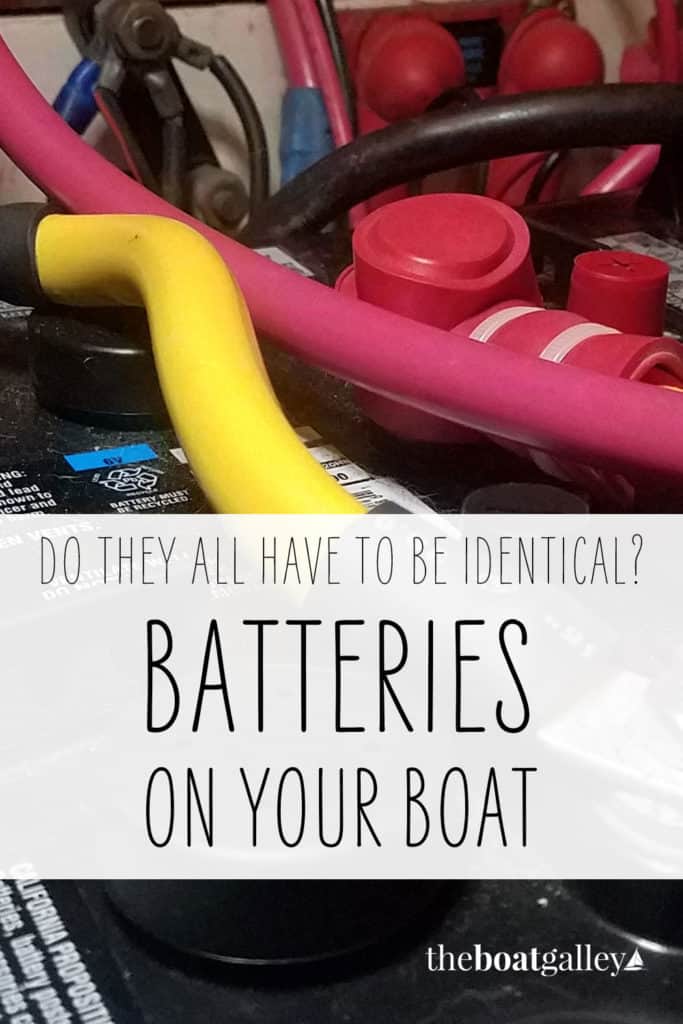
This post is about wet-cell lead-acid batteries and was written in 2016 when we replaced those. In 2019, we upgraded to lithium batteries — read here if you want to know about those. (Learn more about Boat Battery Types here.)
When we bought Barefoot Gal, we knew her battery bank needed upgrading. Her batteries totaled only about 230 amp-hours – and I say “about” since none of her batteries were deep cycle batteries and we had to “guess-timate” the amp hours.
We knew that we needed both a larger battery bank and deep cycle batteries for our full-time life aboard. Deep cycle batteries are designed to provide power over time, whereas starting batteries are designed to provide a quick blast at max power; dual purpose are a compromise between the two.
Our previous boat had Trojan wet-cell deep cycle batteries and we really liked the combination of performance and price. We did do a bit of looking at AGMs and even lithium batteries, but quickly decided that for us, Trojan wet cell deep cycles were the way to go – especially as we’d made battery watering a simple 2-minute chore by installing a watering system last winter.
Last winter, we’d done quite a bit of upgrading to Barefoot Gal’s power system (a new shore charger, Honda generator, battery monitor, watering system, correcting wiring so that the switch actually did switch the batteries off and upgrading the solar charging). When one of the batteries died in the middle of rebuilding the engine, we had simply done an exact swap-out for a new battery: not what we wanted in the long run, but the quick-and-dirty solution while up to our elbows in the engine project.
Why hadn’t we upgraded the batteries then? In a word, space. The battery compartment on a Gemini catamaran is smallish, shortish and oddly shaped around the centerboard trunk. We were going to have to do some careful measuring and planning to get a larger and better bank in there. It was not going to be a simple or quick job. And last winter, we just needed a working battery bank right then. (For those wondering, trying to enlarge the space or move the batteries was an even bigger challenge.)
The good news is that we were able to install 355 amp-hours of much higher quality lead-acid batteries in the space we had – a little more than a 50% increase in amp-hours.
I know that no two boats have the same battery setup, but want to share some things that we learned in the process of this project. NOTE: this isn’t everything you need to know to plan a battery installation, but rather things that we have not found in most discussions. 2019 UPDATE: We now switched to lithium batteries; this article is still applicable if you’re using lead-acid or AGM batteries.
BUSTED MYTH: ALL BATTERIES HAVE TO BE IDENTICAL
For years, we’d heard that all lead-acid batteries in a bank have to be identical: same size, type and age. But it was one of those things that we’d simply “heard,” not something that we knew to be true from an engineering standpoint. I called the Trojan tech support line and spoke with one of their engineers. He told me:
- All batteries in one bank should be the same type – that is, deep cycle vs. starting vs. dual purpose.
- The batteries should be the same technology – that is, wet cell, AGM, gel or lithium.
- The age of the batteries does not really matter; the critical item is that if one battery is in worse shape than the others – as commonly happens when there’s an “old” battery – it will drag the whole bank down. Thus the “rule” to replace all together.
- The size – physical size and amp-hours— of the lead-acid batteries can be different.
- It is okay to mix voltage of the individual batteries IF they are wired in series first so that each series has the same voltage before wiring in parallel.
- Batteries wired in series should be identical in voltage and amp-hours.
This allowed us to get much more creative in our battery configuration! More on what we finally did below.
WEIGHT MATTERS
When planning a battery installation, consider the weight of the batteries and how you’ll have to move them. Lead-acid batteries are heavy!
One of our possible configurations used two 82-pound batteries. We thought about what it would take to get them into the dinghy, out of the dinghy and onto the deck of the boat, and then into the battery compartment. In and out of the dinghy seemed like a good recipe to wrench a back, but at least we could work together there. Getting them into the battery compartment would be a one person job – and the battery would have to be held at arm’s length and lowered into place.
Dave’s strong, but there is no way that he could do that with an 82-pound battery. That configuration was quickly out of the running; the ones we ended up with weighed a maximum of 66 pounds and provided 55 amp-hours more.
SIZE OF THE BATTERIES
Obviously, you have to consider the size of the battery compartment. But for an installation such as ours, where the batteries go through an opening and then are lowered and slid into the battery compartment, the size of the opening matters as well. Having to tilt heavy batteries at odd angles and at arm’s length is something that you probably want to avoid. We had to do a tiny tilt – I just had to push the bottom of the last battery over about a half-inch to slide it in – and we could not have managed much more in the tight confines we were working in.
TERMINAL TYPE
Turns out that you can get all sorts of different types of terminals on batteries. We prefer the threaded studs with a nut so that it’s easy to put more than one wire on a stud. We need this for paralleling batteries and also for putting “sense wires” (for the battery monitor) on the bank. Whatever your preference, make sure to order your batteries with that style terminal – available styles are usually listed in the specs for a particular battery.
BATTERY CARRIERS
Don’t assume that your new batteries will come with carrying handles or, if they don’t, that the carrier you already have will work.
We got our batteries from the store to the marina only to find out that our carry strap didn’t work on the two that came without a handle. That took a trip back to the store to buy the right handle. Check it before you leave the store and you’ll save a bunch of time and hassle.
PLANNING
If you are looking to do something other than a direct replacement, it pays to spend a lot of time playing with different configurations to get the most amp-hours in your space. Measure your space carefully and download the battery specs from the company(ies). Trojan has a nice PDF listing all of their batteries and I spent hours trying different configurations (I’m sure that no salesman or battery installer would have spent the time we did on brainstorming ways to get more in).
One thing that I discovered is that sometimes a company will have two batteries that are exactly the same size, but offer different amp-hours. Trojan T-105 6 volt batteries are what everyone is familiar with, and they offer 225 amp-hours. But Trojan also makes the T-125 that is exactly the same size but weighs 5 pounds more and provides 240 amp-hours. Hmm, an easy way to gain almost 7% more amp-hours – when you’re as tight on space as we are, you need to squeeze in every bit you can!
SERIES OR PARALLEL?
Batteries can be connected in series or in parallel. Series is where you connect the positive of one battery to the negative of another to increase the voltage (only one wire connects the two). The best example of this is wiring two 6-volt batteries to produce 12 volts. Think of this as making a bigger battery with two halves – the positive and negative of the “big battery” are the positive and negative that you did not connect together. The amp-hours of the “bigger battery” are the same as each individual battery.
Parallel is where you connect the positive of one to the positive of another, and the negative to negative. The voltage stays the same and the amp-hours are added together.
Now here’s where it gets fun: you can hook up batteries both in series and in parallel in a single battery bank. So you can connect two 6-volt batteries in series to make a 12 volt “big battery” and then connect that in parallel with another 12 volt battery (or two more 6 volt batteries connected in series) to get more amp-hours. If you’re confused by series and parallel and how they can work together, here is a great description and diagram.
OUR NEW CONFIGURATION
We ended up with two Trojan T-125’s wired in series, producing 240 amp-hours at 12 volts.
- 12 volts
- Deep cycle
- Wet cells
- Identical batteries wired in series
We then wired this in parallel to a Trojan 27TMX, with 115 amp-hours at 12 volts.
- 12 volts
- Deep cycle
- Wet cells
Result: 355 amp-hours at 12 volts and meeting all the requirements that the Trojan engineer had laid out in my phone conversation. He told me that more and more boats and RVs were doing this type of configuration to use every bit of space available. To quote Dave, “I don’t think we could get even a AAA battery more in there.”

Carolyn Shearlock has lived aboard full-time for 17 years, splitting her time between a Tayana 37 monohull and a Gemini 105 catamaran. She’s cruised over 14,000 miles, from Pacific Mexico and Central America to Florida and the Bahamas, gaining firsthand experience with the joys and challenges of life on the water.
Through The Boat Galley, Carolyn has helped thousands of people explore, prepare for, and enjoy life afloat. She shares her expertise as an instructor at Cruisers University, in leading boating publications, and through her bestselling book, The Boat Galley Cookbook. She is passionate about helping others embark on their liveaboard journey—making life on the water simpler, safer, and more enjoyable.
Your VHF can do so much! Learn how to use ALL its features for just $39:
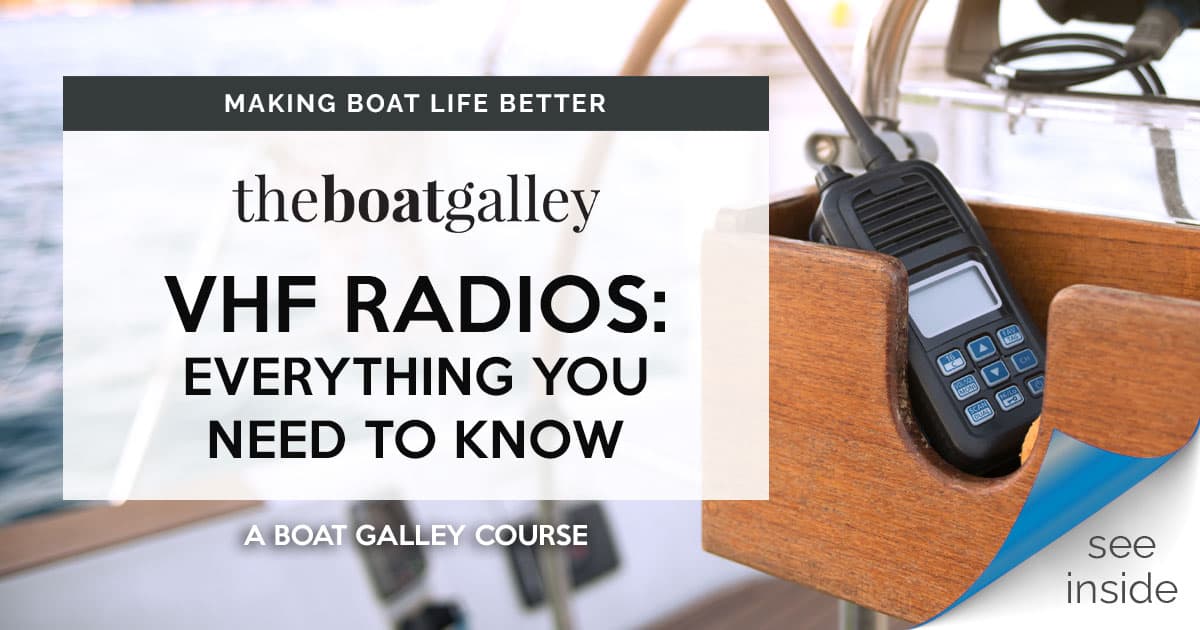
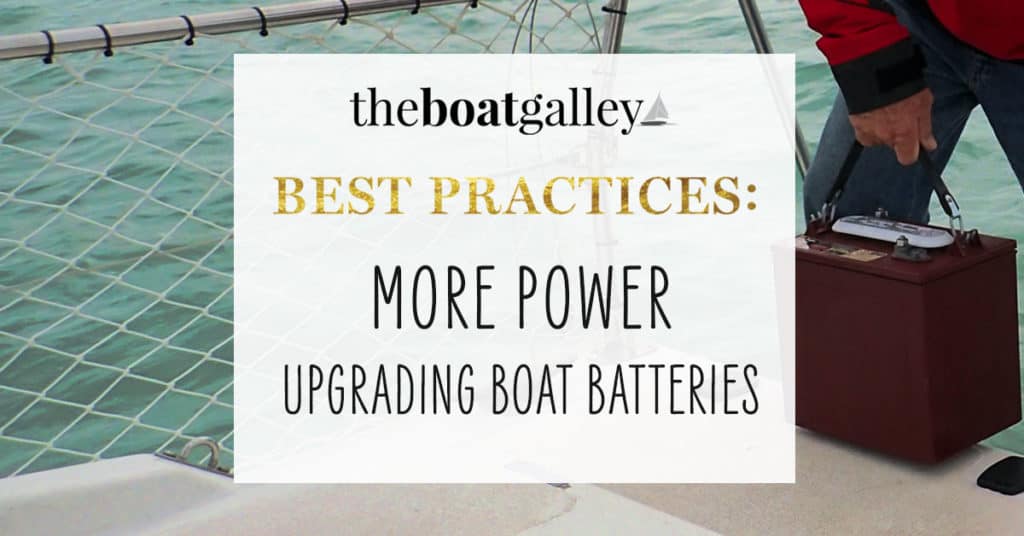
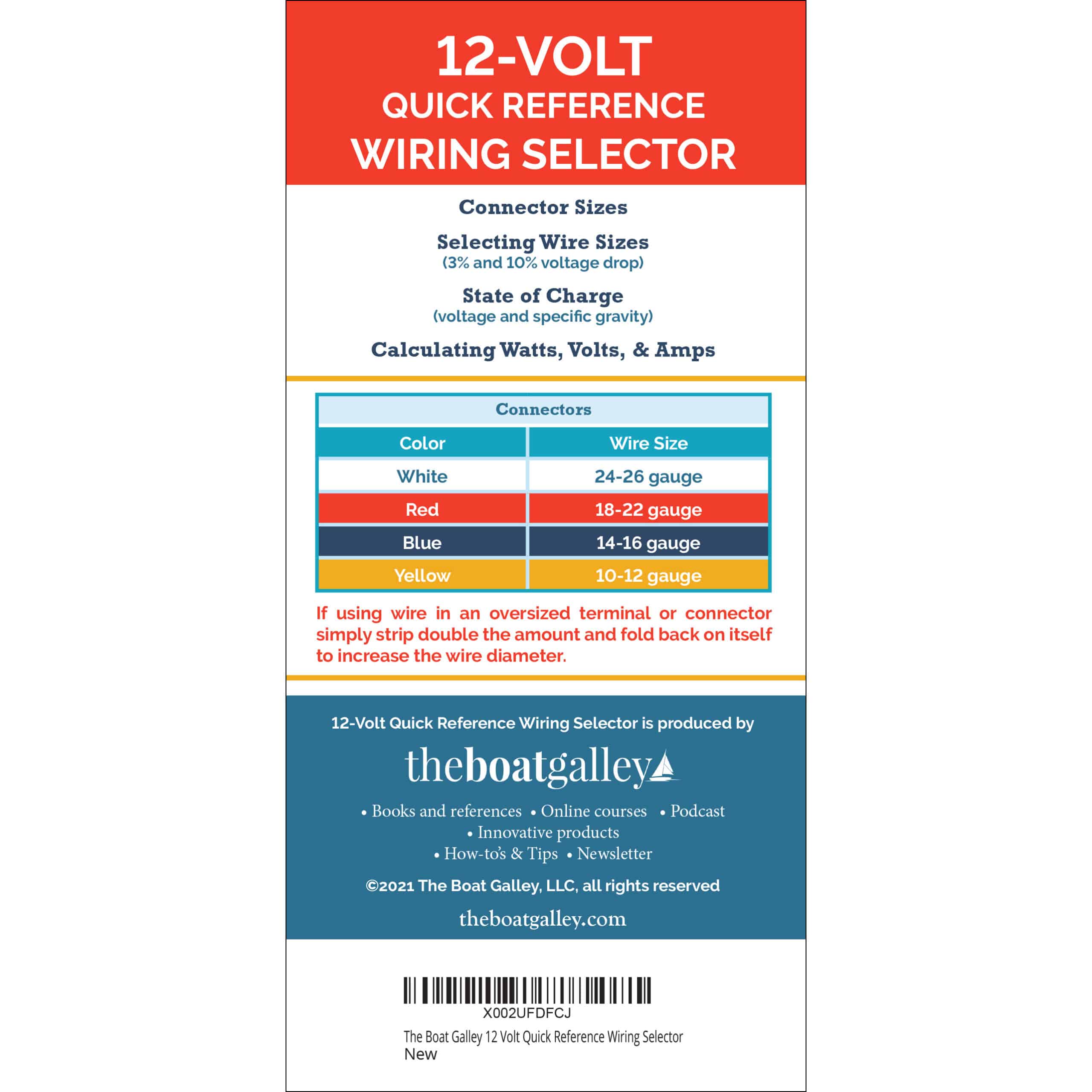


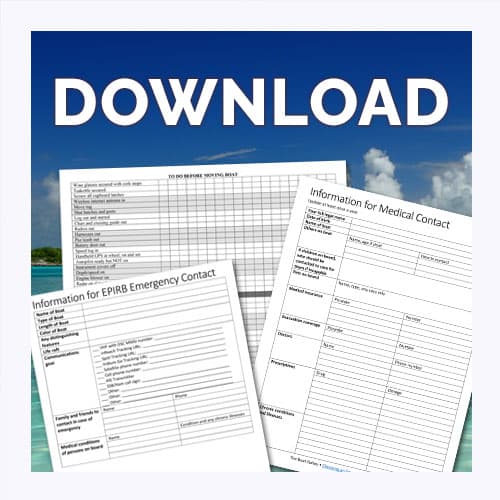






John Rushworth says
Surely differing Ah size batteries of the same type will have differing resistance which can’t help?
The Boat Galley says
Trojan said it’s perfectly okay to do. I trust them as being the experts.
John Rushworth says
Me too, yet I do believe it can make a difference. Did you consider Lithiums? Ah for Ah and cycle life makes them a comparable cost alternative. And of course they weigh less and pack more punch by volume. I have an AGM 24v house bank 130 Ah @ 20 HR rate with DC to DC for 12V. I use Lithium ion for my electric propulsion bank. The voltage is so incredibly stable under high loads. No absorption phase either to speak of. Fast recharge too. Having said all that I understand your reasoning although I’m not sure flooded batteries are the safest alternative for a boat. I like the increased safety of the watering system though. I use Victron Energy products to monitor and charge my systems. And a declaration of interest. I did choose them before I started blogging for them! Look forward to hearing how your new system performs.
Les Bauman says
I replaced my 3 agm’s about 500 pounds with 1 lithium about 70 pounds,about same amp hours and 1/3 the space needed. What steered you away from lithium?
Chris says
I replaced my old AGM batteries with new ones about a year ago. Seeing how much prices have already come down, I’ll most likely make the move to lithium next time. Where there any other changes that needed to be made to your system to make the switch from AGM to lithium?
The Boat Galley says
Les Bauman We did consider lithium, but the cost was just out of our current budget. Talking to the local expert, part of our charging system would have to be redone, too. We would have spent over $3000 by the time we were done whereas this cost just under $600. Yes, perhaps over the lifetime it would equal out, but we also have to keep an eye on current spending. Getting all the spares, etc. that we need to really cruise this boat is expensive (expected, but nonetheless there is a budget). When we have to replace these in 5 years or so, we’ll look at lithiums again.
John Rushworth says
That makes sense. Energy density by volume and weight may increase by then including changes in chemistry and hopefully a reduction in price. Meanwhile I’ll stick with AGM for my domestics. Whose Lithium did you go for Les Bauman.
BMS & cell balancing or not?
John Rushworth says
Les Bauman Same Ah maybe but way more useable capacity compared to AGM.
The Boat Galley says
John Rushworth That’s exactly what we’re thinking — there have been huge improvements in battery technology lately, and hoping that it’s like electronics — improvements continue and prices drop.
John Rushworth says
It won’t follow Moore’s law but all improvements are welcome. I know having fitted my own Lithiums it’s a new learning curve too. I was lucky in that I could reprogram my 24V/25A 4 stage digital charger for Lithium. It’s a Victron Phoenix I’m using and their fab Multiplus charger/inverter on the AGM bank. I love their power assist so if I’m using my 900 Watt continuous Honda genny I can still get 1,600 Watts of AC power with the Multiplus 800 Watt inverter (700 continuous) power assist function. Very handy if using the genny to charge Lithiums and I still want to use my 600 Watt kettle at the same time taking power from genny and inverter at the same time via a fast seamless transfer switch built in. All this learning, wasn’t it simpler when we just had sails, a clock and compass!
Les Bauman says
John Rushworth I used LiPo4. I love them, I have 580 watts of solar and they can push a lot of current into the lithium’s in short amount of time. I’m using a outback controller
John Rushworth says
Not enough room on my boat for that amount of solar. Nice. Guess I better start saving for Alain Janet’s solar cloth sails! Mine are LiPo4 too. Probably best tech for boats.
Jim Shell says
Where did you get your information that you can mix Ah sizes? The Trojan Company? I would like to verity that concept. Kudos for finding the T-125, the 7% increase is significant.
Carolyn Shearlock says
I called Trojan’s 1-800 number — the customer service rep put me through to an engineer. After getting the general info, I specifically asked about the mix we went with.
Becky says
Funny: Because your article has the words ” size matters” and “Trojan,” Amazon suggests your readers would like to buy similar products about “male enhancement!”
Carolyn Shearlock says
Oh geez. I took out the phrase about size; hopefully that will change the results.
Dave&Lisa says
You can never escape the seedy side of the internet, even on a blog about batteries.
Kelly says
Becky – Made me laugh too! Good ol’ Amazon trying to offer suggestions. No worries Carolyn. I’m sure it isn’t the first time Amazon recommendations have been ‘off the mark’. lol
Raquel Hernandez says
Brian Liddy
Teri Maunder says
John, good read.
Stacey says
I’m looking at the Trojan Battery Guide PDF you linked to, specifically the bottom of page two. Can you confirm what # Terminal you decided on? Lots of options seem to fit the threded stud with nut that you describe. Thanks!
Carolyn Shearlock says
The #1 is the “standard” on the 6-volt batteries, and we went with that (it’s about 1/2″ shorter than #2). On the 27TMH, we went with #9 (and for some reason, it had a hex nut when we got it, not a wingnut, and that’s fine with us, too). All the ones with studs are 5/16″ diameter; it really doesn’t matter which threaded stud you choose, just that if you want a threaded stud, make sure not to pick, say, #7, the Universal.
Stacey says
Thanks Carolyn! Any reason not to choose #11?? Obviously, I’ll ask the Trojan guy, but any experience and info you can share is always helpful!
Carolyn Shearlock says
It just comes down to which terminals are available for the batteries you want. We’d take any of the threaded stud ones, but certain batteries only come with certain ones. The chart shows the available ones for each battery.
JOHN says
Just checked pricing for the T-105 vs the T-125 —T-105s for $150 and the T-125 for $173 —-yes a 7% increase in amp-hours but at a 15% increase in costs — so for a battery bank of six 6 volts increased costs would be about another $150 –still good to know ‘though so thanks
John Liniger says
Great info. Have you had any issues with your watering system? I replaced my Trojans and installed the Trojan watering system about 6 months ago. I changed nothing else but now see significantly increased water consumption. There is no spillage or overflow at all. Just went from needing a little topping off at the end of each month to needing about 1/2 liter every two weeks. The electrical needs and daily usage have not changed at all.
The Boat Galley says
No, none at all.
John Liniger says
I’ll have to dig a bit deeper. Thanks!
Dylan-Kim Phan-tastic says
Pictures please. Thanks!
The Boat Galley says
I’m not sure what you want pictures of. The batteries are pretty hidden in their compartment . . . plus, what works in our boat — our battery compartment — is unlikely to work exactly on yours.
Dylan-Kim Phan-tastic says
Just want to see how you incorporated parallel and series set up. Thanks!
Gerry Connolly says
Good article, thanks for sharing.
Mark Sierakowski says
Robert Karlson, may be of interest. The summary of battery types, from is worth a read.
Peter Clark says
Pity they didn’t get LiFePO4, imagine have lethal hydrogen floating around your boat from wet cells..
Sterling Kennedy says
there has to be a book in your future.
Denis Oudard says
We loved our Trojan on Beagle Knot. We used four T105 for a total of 490 Ah at 12v.
Anonymous says
Hi carolyn,
Thanks for the great capsules of info, fyi, the link to the wiring diagram on atbatt.com does not work anymore
The Boat Galley says
Thanks! I just changed it in the article. Try this one: https://www.batterystuff.com/kb/articles/battery-articles/battery-bank-tutorial.html
Pacific NW Boater says
This is a good article. However, we have been VERY happy with our now 3 yr old carbon fiber (Firefly Oasis) batteries from Bruce Schwab at Ocean Planet Energy. Nigel Calder is a big fan of them, too.
Anonymous says
Hmm…..according to the battery specs the T105 and the T125 are different sizes ?
The Boat Galley says
They weren’t when we bought ours, which is now almost two years ago. Things may have changed.
MikeB says
I’m currently using 6 Firefly L15 batteries, I have found them to be extremely tolerant of any abuse you confront them with, extremely satisfied. I have oftentimes used the smallest block and tackle, supported by a 2×4 frame to lift/move heavy objects like batteries, even my wife can do it. It can be easily adapted to many problems, just stop and figure it out, not rocket science.
Linda says
Great article, we are the new owners of a Gemini 105mc too!!! So do you also have a separate starting battery? And is that located back by the engine?
Carolyn Shearlock says
No, we do NOT have a separate start battery. The engine is only 27 HP and doesn’t need that much cranking power.